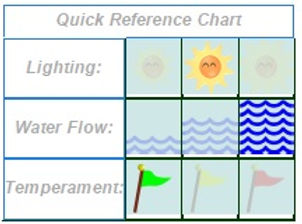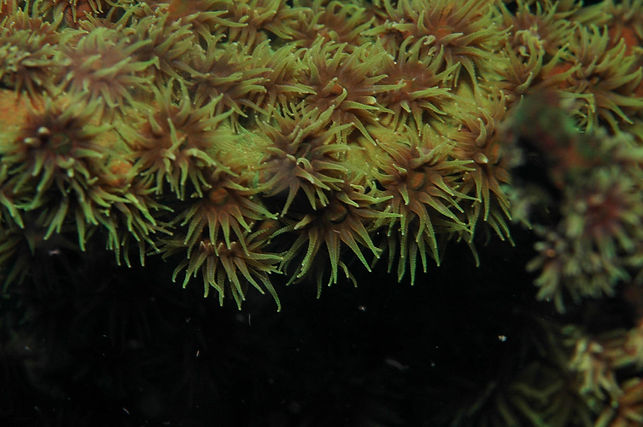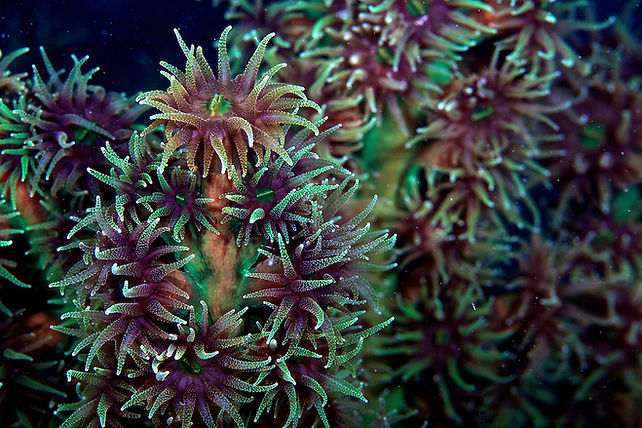The Large Polyp Stony (SPS) corals have large polyps on a calcerous skeleton!
Hard corals are generally broken down into two categories; large polyp stony (LPS) corals and small polyp stony (SPS) corals. The LPS corals are generally larger calcareous corals. They have much larger fleshy polyps than those of the small polyp stony (SPS) corals.
Many LPS corals are quite hardy and can even be fast growing. These stony corals are generally easier to keep in the aquarium than the small polyp stony (SPS) corals. For the most part they require less intense lighting and a lower water movement than SPS corals.
Both of these types of corals lay down calcium on a hard skeleton via the polyps. Thus the name names stony coral or hard coral. This means they require adequate levels of calcium to thrive. Generally a level above 400 ppm is desirable. Many authors recommend 430-480 ppm calcium for these corals. Other elements needed for many of these corals to thrive are strontium, iodine, and trace elements. Many of these corals can be fed small bits of seafood (shellfish, crustaceans, squid, fish), but as they derive much of their nutrition from the zooxanthellae contained in their tissue, feeding is usually not necessary.
Corals like these will propagate either by spawning or by "budding". This means the parent will grow small corals that will separate from the parent, or the parent will simply separate into multiple corals.
Many of these corals have long stinging tentacles called 'sweeper tentacles' which serve to cut down on competing corals in the nearby vicinity so you must give them plenty of room in the aquarium.
10 Easy LPS Corals for Reef Tank Beginners
courtesy to :www. homeaquaria.com
Corals encompass a broad and interesting range of species. Some of the most popular corals for beginners in the saltwater aquarium hobby include LPS corals; which is simply an acronym for large polyp stony corals.
There are a few SPS corals (small polyp stony corals) that are also recommended for beginning enthusiasts, but these require a lot more care than their large polyp stony coral relatives.
- Difference Between LPS vs SPS Corals :
The main defining differences between an LPS coral and an SPS coral are (obviously) the difference in the size of their polyps, and the difference in their light and food requirements.
The larger the polyps on the coral are, the easier it is for the coral to feed appropriately. This is because the polyps on the coral contain the incredibly tiny organism known as zooxanthellae, within their tissue.
This zooxanthellae; or photosynthetic algae; provides the coral with food; but only if there is enough light absorbed through the polyps.
- Why LPS Corals?
Large polyp stony corals are popular amongst beginner aquarists for several different reasons.
They require far less light than many other species, and therefore require less expensive lighting equipment for their aquarium set up.
They are far more likely to breed or successfully fragment in captivity than small polyp stony coral are.
They require less maintenance, such as; water changes, chemical adjustments, temperature regulation, etc… This is not to say however that they are easy to care for.
Like any salt water marine animal, these LPS corals are rather sensitive and will not thrive unless all of their needs are met consistently.
- 10 Easy LPS Corals to Start With :
I’ve constructed a short list of very aesthetically pleasing, easy to care for, large polyp stony corals that are great for beginners. Don’t feel limited by this list by any means however; as there are dozens of others that are equally easy to establish and care for.
There is a lot of research involved in putting together a well balanced, healthy salt water coral aquarium. This list is just a helpful starting point for those who have enough knowledge that they’re prepared to just jump right in and get started.
1. Trachyphyllia sp.
Large Polyp Stony Corals :
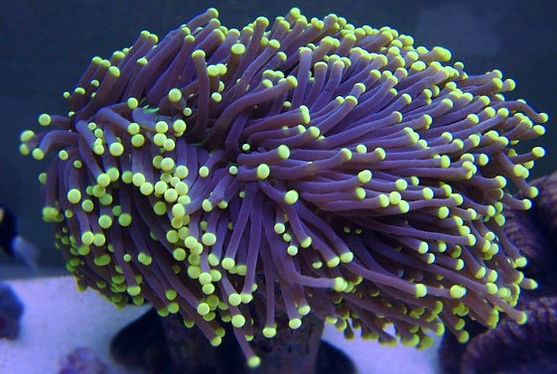



The Trachyphyllia sp. (commonly known as a Brain coral) is a bright, relatively small species.
It is semi-aggressive towards other fish and invertebrates.
It prefers to be placed at the bottom of the aquarium, where it has access to medium water flow.
It requires moderate light; meaning that a basic salt water aquarium light set up should be sufficient.

2-Caulastrea furcata
The Caulastrea furcata (commonly known as a Candy Cane coral) is a little less flashy than some of the other corals, ranging from tan to pale orange in color, and being rather small.
It is a peaceful species for the most part, however observation to ensure this behavior is recommended.
It requires moderate light and medium water flow.
It is comfortable being placed almost anywhere in the aquarium.

3. Caulastrea curvata
The Caulastrea curvata (commonly known as a Trumpet coral) is aptly named; shaped like a small yellow trumpet.
This is yet another peaceful species of coral that does well with others.
It prefers to settle in somewhere between the bottom and the middle of the aquarium.
It requires moderate light, and medium water flow.
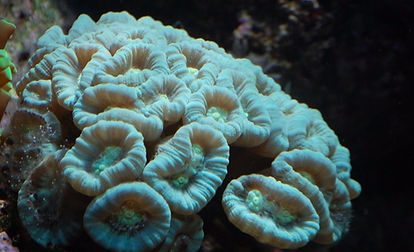
4. Plerogyra sp.
The Plerogyra sp (commonly known as a Bubble coral) is a very unique coral.It looks like a pink cluster of grapes upon first inspection.
Do not let its gentle and soft appearance fool you however, this species is rather aggressive.
It requires open space somewhere between the bottom and middle of the aquarium, where it is unlikely to be able to attack other specimens.
It requires moderate light, and low to medium water flow.

5- Fungia Repanda :
The Fungia repanda (commonly known as a Short Tentacle Plate coral) is an unusual coral.
It is relatively flat, and disc shaped with hair-like tentacles.
It is semi-aggressive towards other invertebrates and fish.
It prefers to reside at the bottom of the aquarium.
It requires moderate lighting, and low to medium water flow.
6-. Lobophyllia sp.
The Lobophyllia sp (another species that is commonly known as a Brain coral) is a magnificent, bright orange species that is semi-aggressive as well.
It is comfortable being placed almost anywhere in the aquarium, but it does require moderate to high lighting; meaning that it should probably reside closer to the top.
It prefers medium water flow.
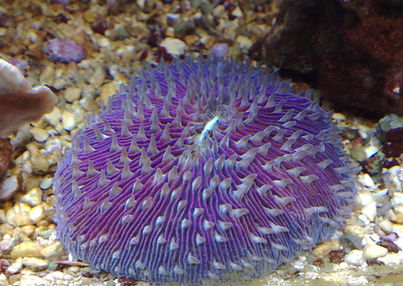
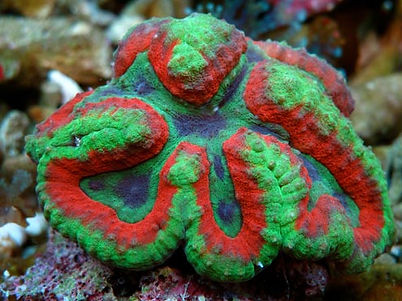
7- Favites spp.
The Favities spp (another species that is commonly known as a Brain coral) is one of the few aggressive species recommended for beginners.
It does not typically cause problems as long as it is given space.
It is comfortable being placed anywhere in the aquarium.
It requires moderate lighting, and medium water flow.
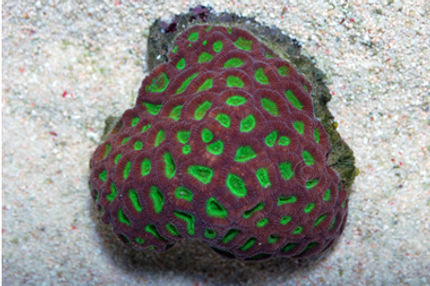
8-Nemenzophyllia turbida
The Nemenzophyllia turbida (commonly known as a Fox coral) is a spectacular display coral.
It is very uniquely shaped and textured; typically a pale pink, velvety looking creature with dozens of folds in its body.
This species is very peaceful. It prefers low to moderate light, and does well on the bottom of the aquarium.
It requires low water flow as well.
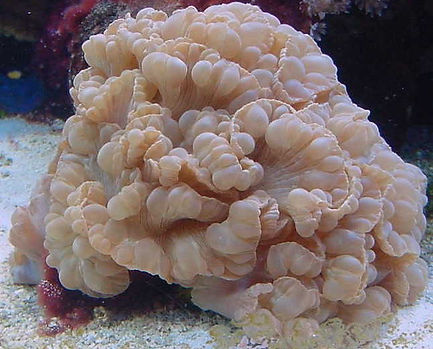
9-Cynarina sp. :
The Cynarina sp (commonly known as a Button coral) species is known to be peaceful towards other invertebrates and fish.
It is a small, round coral with variegating shades of red, purple and blue.
It is most comfortable somewhere between the bottom and the middle of the aquarium.
It requires moderate lighting, and low water flow.
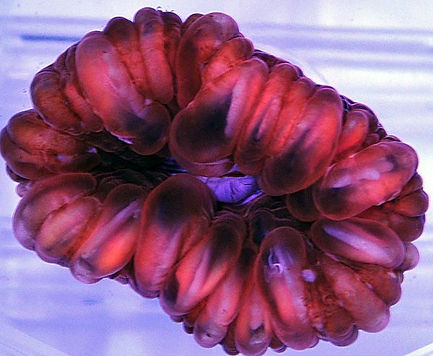
10-Turbinaria peltata
The Turbinaria peltata (commonly known as a Pagoda Cup coral) is yet another aptly nicknamed coral.
It is typically green, and is shaped like tiny pagoda cups.
It is a peaceful species that prefers to dwell at the bottom of the aquarium.
It requires moderate lighting, and medium water flow.
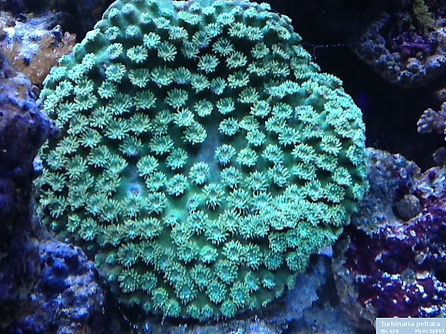
It should also be noted that your tank must be set up and have a healthy, well established eco system before you begin placing corals of any kind in the aquarium.
You may have to adjust things like water turgor, flow and quality after placement of your large polyp stony corals; they require careful observation during their settling period. If they do not colonize, keep an eye on them to make sure that they are not damaging or harming one another.
Many species have long ‘sweeper’ tentacles covered in cytoplasts that they use to clear the area around them and establish their territory.
Placement of Corals in the Reef Tank :
Up until the last few years, if you asked under what conditions a coral would do best, 80% of the time the reply would be "good light with moderate current," 10% of the time, the reply would be "toward the bottom with little current," and 10% of the time, the reply would be "take your best shot." Fortunately, for the most part, these answers were correct in that most tanks used fluorescent lights of some type and the only types of corals being kept were soft corals, large polyped stony (LPS) corals, and mushroom anemones. The only precautions that we had to take in terms of coral aggression was to keep the soft corals far enough away from Hammer (Euphyllia ancora), and Elegance (Catalyphyllia jardinei) corals to keep them from being stung. Otherwise, not much thought was actually given to coral placement and its long-term effect on the animal's well being.
Care of Corals - LPS
With the dramatic improvement and widespread use of metal halide lighting, and the increasing availability of new coral species, particularly the small polyped stony (SPS) corals, these stereotyped answers to coral placement questions are no longer valid. The three main factors to consider in placing corals are aggression, lighting, and water movement.
Aggression :
Today, more attention needs to be given to reducing aggression, since many of the newer species of corals that we are now keeping are much more aggressive. This aggression has also become more of a problem as a result of our being more successful at keeping corals in general. That is, as we have become more skilled at actually growing coral colonies, our corals are growing to larger sizes. As the size of these corals increases, so too does their proximity to each other, and as a result, more of their aggressive nature manifests itself. Thus, while their aggressiveness was hardly observable and not a problem when they were a small, three inch colony, their effect on neighboring corals becomes dramatically noticeable when they are twelve inches across.
Types of coral aggression :
Corals have developed several specialized mechanisms for protection and competition with other corals. These include sweeper tentacles, mesenterial filaments, and terpenoid compounds (Ates, 1989).
Sweeper Tentacles: Sweeper tentacles are the most common defense mechanisms in the hard corals, and also occur in some soft corals. Specialized stinging cells called 'nematocysts' are present in these tentacles and can attack a competing coral and literally "burn" it to the point of either killing it or severely damaging it. The length of these sweeper tentacles is not correlated to the length of the normal coral polyp and may, in fact, be many times longer.
Mesenterial Filaments: In addition to sweeper tentacles, several hard coral species can produce mesenterial filaments (also termed mesenteric filaments) from their stomachs. Corals of the genera Favia, Favites, Scolymia, Pavona, and Cynarina all have this capacity (Chadwich, 1987). These filaments can kill or devour other coral polyps through a process similar to digestion. Some corals even have the capacity to produce both sweeper tentacles and mesenterial filaments, enabling them to fight a battle on several fronts (Wallace, 1984).
Terpenoid Compounds: The soft corals generally compete with the hard corals by releasing 'terpenoid' or 'sarcophine' compounds into the water to injure or impede the growth of neighboring corals, and then overgrow these impeded individuals in a process called "allelopathy" (Delbeek and Sprung, 1994). Like their name implies, these compounds are similar to turpentine in chemical structure and in most instances, are just as toxic. By releasing these compounds, the soft coral injures these neighboring stony corals and can thus grow above them, eventually blocking out the light that they are both dependent upon and thereby killing the underlying hard coral.
Use correct spacing :
While a miniature reef does not contain the great diversity of life that an actual reef does, provisions should still be made to try and minimize the aggression among corals. This can be accomplished by providing adequate spacing and reducing tip over potential. When setting up a tank, adequate space, which is invertebrate free, should be given around each coral head.
Hard Corals: For LPS corals, this zone should be at least 15 cm in all directions, as sweeper tentacles have been reported to be at least this long (Sheppard, 1982). The distance between SPS corals does not need to be as great; a distance of 5-8 cm is usually sufficient. However, it should be noted that these are the fastest growing of all corals, so extra space should be allowed for this. For this reason, I suggest that a buffer zone of 30% of the coral colony's size be used when originally placing the corals in order to allow for growth. This may seem extreme and may initially make the tank look sparsely decorated. However, in a well-designed and maintained reef tank, this space will be almost completely filled within the first year simply from growth. If growth space is not provided, there will be a constant need to prune corals lest they burn and kill one another.
Soft Corals: For the most part, the space between soft corals does not need to be as great initially, since soft corals do not burn each other to the same degree as the hard corals do. Consideration in placing soft corals needs to take into account:
- A faster growing coral will overshadow a slower growing coral and eventually starve it out for light.
- These corals should be positioned so that their mucous and terpenoids do not come into direct contact with their neighbors. That is, these corals will do the least harm to other corals if the water movement in the tank is such that after the water moves across them it flows down an overflow and into a sump where the harmful compounds can be removed with either skimming or carbon.
Minimize tip over potential :
Tip over potential is the likelihood that one coral will tip over and land on another coral, and as a result, burn or be burned by the other coral. The burned area becomes infected and consequently, the whole colony dies. Tip over is particularly troublesome for SPS corals, which usually arrive unattached to anything. Therefore, when placing these corals on a live rock structure, use a dab of waterproof epoxy to hold them in place until they encrust over the area themselves. An alternative is to use rubber bands or plastic cable ties to anchor the colonies in a less permanent manner.
Light preference :
When placing a coral, consideration of its lighting and current requirements should be made long before it is placed in a particular location. This is because moving a coral, even a small distance once it has adapted to conditions at one spot, causes the coral to "re-adapt" to these new conditions. It has been my experience, that it takes at least one month and closer to two for a coral to adapt to new conditions and start to grow. Therefore, placement should be planned so as to not inhibit the coral's growth by constantly moving it from place to place.
There are multiple types of lighting systems that can be used for corals.
Fluorescent lighting :
Fluorescent lighting is still the method of choice for most reef enthusiasts, particularly those keeping predominantly soft and large polyped stony corals. Fortunately, even in fluorescent lighting there are now many choices. In addition to standard bulbs, high output (HO) and very high output (VHO) bulbs are also now available, as well as compact HO and the very latest T-5 (HO) lights. As their names imply, these bulbs differ by the amount of light that they produce. It is my opinion, that for the majority of tanks housing soft corals and LPS corals, fluorescent lighting will provide all the light necessary to meet the animals' needs and allow them to thrive and grow. The goal should be to get between 4-6 watts of light per gallon of water over the tank.
However, even with fluorescent lighting and more so with HO and VHO fluorescent lighting, care needs to be exercised when placing the animals under a new lighting regimen. This is because many of the lighting sources that we utilize contain more ultraviolet (UV) light than the corals are accustomed to on a reef. Because of this difference, I have found it advantageous to slowly acclimate new corals to artificial light. If the corals are not acclimated slowly, it may cause them to bleach or burn. This is particularly the case with the HO or VHO "blue" bulbs that we use, as well as with many of the metal halide lamps.
For this reason, when I obtain a new coral, I usually place it at the bottom third of the tank for at least one month. After this one-month acclimation period, I gradually move it up to its desired final location over another two-month period. This may seem extreme, however, I view my tanks and the tanks that I have helped set up as long term, five-year plus projects, so there is really no need to hurry. I use this method for SPS corals, which show the least tolerance for being shocked, owing to the thin veneer of living tissue that is actually present on the colony. It is also useful for large polyped stony corals like Brain corals (Symphyllia, Favia), Open Brain corals (Trachyphyllia), Elegance (Catalyphyllia), as well as any other corals that contain a large amount of bright green pigment in their tissues. It has been my unfortunate experience, that if I immediately place these corals high up in the tank, they bleach and die very quickly. Because of this, I now employ this system of acclimation, and as a result, I have achieved much better results when adding new corals to a tank.
Metal halide lighting :
In tanks utilizing metal halide lighting, I suggest using the same system as described above, with a few addendums. First, for those corals that contain a lot of zooxanthellae (the symbiotic algae that lives in the coral's tissues), as indicated by their coloration being dark green or dark brown, in addition to starting these corals low it may also be necessary to initially place some type of screening material (eggcrate, fiberglass mesh, etc.) above them. This is necessary to prevent these corals from suffering from oxygen shock due to the overproduction of oxygen from the zooxanthellae when initially placed under bright light (Delbeek and Sprung, 1994). This screening material needs to be above the corals for two to three weeks to gradually allow the corals to acclimate. Once this is removed, the corals can continue to be acclimated as described above. This screening technique is also useful for tanks that are shallow (16 inches deep or less) where it is difficult to move a coral farther away from the light. In addition, during this time, the light cycle should be dramatically shortened to further reduce the risk of shocking the corals. Cutting the light cycle in half for the first week, and then gradually adding an hour to it each week is a good way to reduce the risk of light shock.
In terms of placing the corals once they have acclimated, the general rule is the brighter the color of the coral, the closer to the lights it should reside. Thus, bright pink Bird's Nest (Seriatopora hystrix) or Cactus (Pocillopora verrucosa) corals usually should be placed higher in the tank than their brown counterparts. The reason for this is that the brighter color indicates pigments in the tissue have been produced to protect the coral from ultraviolet (UV) light that is present in the shallower depths (Delbeek and Sprung, 1994). Once a coral has been acclimated to this bright light and begins to grow, the growth tips will usually be of a brighter color than the original colony itself.
This same pattern also holds for soft corals. Brightly colored soft coral colonies like Yellow Tonga Leather corals (Sarcophyton elegance), bright green Finger Leather corals (Sinularia sp.) and white Xenia colonies all seem to do better with brighter lighting than their brown or beige counterparts. If the lighting is inadequate for these brightly colored corals, these bright colors will gradually fade over time. Therefore, a good indicator of whether a coral is in the proper place and under adequate lighting is how its color compares with what it looked like when it originally arrived. If the lighting is better and the coral is acclimated properly, it is even possible to bring out the colors of a coral, so that over time, it may be more green or pink than when it was originally collected. This is the result of more UV light being present in our reef tanks than the coral was exposed to in the wild. Thus, to compensate for this, brighter pigmentation occurs.
Under metal halide lighting, many corals can remain at the bottom of the tank. Mushroom anemones (Actinodiscus sp.), Plate corals (Fungia sp.), Tongue corals (Herpolitha sp.), and Brain corals (Favia, Favites, Symphyllia, etc.) all do quite well in the lower depths of these tanks. In addition, Elegance (Catalyphyllia) and Bubble (Plerogyra) corals seem to do better under metal halide lighting when placed lower and to the far sides of my tank. In fact, in my tank, the Bubble coral resides under an overhanging Leather coral and is doing quite well.
Water movement :
The last factor to be concerned with in terms of coral placement is water movement. Most corals have very little means for cleansing themselves, and rely on strong water movement around them to perform this task. That is why powerheads or some other source of water movement are so essential in a reef tank. Otherwise, detritus will settle on the corals and decay, which quickly leads to algae formation and the demise of the coral. However, not all corals require the same amount of water movement.
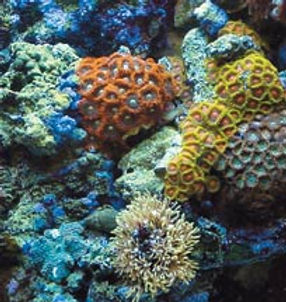
Strong Current Corals: Corals that do best with strong water movement usually come from areas where wave action is greatest. These corals usually have small polyps and are either bulky or encrusting in form (Veron, 1986). Corals such as Porites, Turbinaria,Symphyllia, Acropora paucifera, etc., fall into this category. These corals can take the strongest water movement in a reef tank, as they live on the outermost slopes of the reef.
Moderate Current Corals: The next group of corals requires moderate current, as they come from the lagoons and back reefs where the current is not as great, and in fact, may be limited to the changing of the tides. Nevertheless, if adequate water movement is not present, these corals will not thrive. Most of these corals have either large polyps or are fairly large polyped encrusting corals. Corals such as Star polyps (Clavularia sp.), Flowerpot (Goniopora sp.), Leather and Finger Leather (Sarcophyton and Lobophyton), and Plate (Fungia) corals fall into this category. The next group requires even more moderate water movement and includes Soft Finger Leather corals (Sinularia, Nepthea), Colt coral (Cladiella), Polyp rock (Zoanthid sp.), andEuphyllia and Elegance corals.
Low Current Corals: The last group still requires water movement, but it is only a trickle relative to what the first groups of corals should receive. This group includes Mushroom anemones (Actinodiscus sp.), Elephant Ear anemones (Rhodactis sp.), and Bubble corals (Plerogyra).
In many instances, the difference between success and failure with a particular coral specimen has often been the result of moving an animal several inches in relation to the water movement. Also, when I have had an animal that was not thriving, it was generally due to inadequate water movement rather than too strong of a current.
Conclusion :
Besides the three aspects of coral placement described above, there are many other factors that need to be considered. My goal, however, was to provide general guidelines and factors to be considered rather than the actual requirements for every coral species. However, I would like to point out two rules that are generally true:
-
Corals hate to be moved and require time to acclimate to new conditions.
-
If a coral is not thriving in a location after two weeks, then chances are it will die unless you move it.
Sorry for the ambiguity, but the real message of this article is that only by observing your animals and experimenting will you find the optimum location to place your charges.
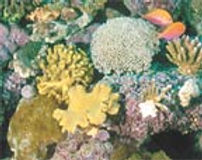
LPS Species List :
- Family: Dendrophylliidae :
1- Black Sun Coral
Branching Black Sun Coral, Black Tube Coral
Black Cup Coral, Black Tubastrea, Green Sun Coral
Tubastrea micrantha
The Black Sun Coral is very intriguing, first in name and then with its gorgeous appearance!
The color and growth form of the fascinating Black Sun CoralTubastraea micranthus will peak the interest of all coral enthusiasts. They are also known as the Branching Black Sun Coral, because they form erect colonies that are richly branched and tree-like. In the wild, these colonies can reach 40" (1 m) in height. At this time, they are the only discovered branching version of this genus.
The Black Sun Coral has very fleshy polyps with its corallites, the hard round, tubular structure the polyps live in, situated on the branches. The corallites are covered with a tissue, called the coenosteum. Their polyps tentacles can be a greenish black to brownish black with the very center of the polyps and the coenosteum and being olive green to brownish black. The colors can be variable, but the polyps are not the dark brown or black that can be found on the coenosteum.
The polyps of the Black Sun Corals extend mostly during evening hours, though they can be coaxed out during the day if food is present. During the day, the coral is completely withdrawn and only the dark coenosteum is visible, making it look like a tree with raised round flat nubs all over the branches. Other common names these corals are know for are Black Tube Coral, Branching Black Sun Coral, Black Cup Coral, Black Tubastrea, and Green Sun Coral.
Although the other species in the Tubastraea genus are referred to as non-reef building corals, or ahermatypic, T. micranthus is actually considered hermatypic or reef building. This is due to the fact that their skeleton is not only denser than the rest of the species in this genus, but denser than most corals on the reef.
The T. micranthus are some of the most durable corals in the ocean, resisting damage by the strong forces of nature, like hurricanes and cyclones. Their surprising strength was also noted when, even after nuclear blasts, the T. micranthus was one of only a few corals that were not fully demolished and still adhering to the reef. Despite its hardiness in the wild, the Black Sun Coral is a delicate coral to handle. Its fragile branches will break easily, so It must be moved carefully by picking it up from its underside.
The Black Sun Coral is moderately difficult to care for and labor intensive. It needs several daily feedings, good filtration, a very strong water movement, and regular substantial water changes. In the average aquarium it is near impossible to provide the extreme water movement and extreme amount of food needed for its captive survival. It is only recommended for the advanced aquarist. Its success depends on a very dedicated aquarist who can provide the right environment and the on-going care of this beautiful coral.
Scientific name Family: Dendrophylliidae
Species: Tubastraea micranthus (T. micrantha)
Distribution / Background :
Tubastraea Coral Information: The Tubastraea genus was described by Lesson in 1829. These corals are referred to as azooxanthellate or non-photosynthetic corals, which means they only survive with foods, and lighting has no affect on their growth. They are also mostly non-reef building corals, or ahermatypic, with the exception of T. micranthus that has a much denser skeleton.
There are 7 Tubastraea species. They are the Yellow Sun Coral or Golden Cup Coral T. aurea, Orange Cup CoralT. coccinea, Brown Cup Coral T. diaphana, Orange Sun Coral T. faulkneri, Floreana coral T. floreana, Black Sun Coral or Green Sun Coral T. micranthus (previously known as Dendrophyllia migrescens), and T. tagusensis. Some common names the Tubastraea species are known for are Orange Cup Coral, Brown Cup Coral, Pink Cup Coral, Rose Coral, Orange Polyp Coral, Black Tube Coral, Sun Coral, Black Sun Coral, Golden Cup Coral, Sun Flower Coral, Tube Coral, Green Cup Coral, and Black Branching Sun Coral.
The Black Sun Coral Tubastraea micranthus was described by Ehrenberg in 1834. T. micranthus, rather thanmicrantha, is the spelling that is recognized by ITIS, the Integrated Taxonomic Information System. Some other common names these corals are know for are Black Tube Coral, Branching Black Sun Coral, Black Cup Coral, Black Tubastrea, and Green Sun Coral.
Where Tubastraea Corals Are Found: The T. micranthus are found in the Indo-Pacific and the Red Sea.
Tubastraea Coral Habitat: The T. micranthus are the deepest dwellers of this genus, being found at 160 feet (50 m). They are found on fore reef surf zones along with other hermatypic corals and reef fauna, in extremely strong waters which flow at a rate of 3 feet per second (1 m per second). This strong laminar flowing water provides the Branching Black Sun Coral with a rich supply of zooplankton at an amount that is near impossible to duplicate in captivity.
Status :
The T. micranthus is not on the IUCN Red List of Endangered Species.
Description :
What do Tubastraea Corals look like: The T. micranthus form branching colonies that can reach 40" (1 m) in height. Their Corallites, or the hard round, tubular structure the polyp lives in, are situated on the branches. The corallites are covered with a tissue, called the coenosteum.
The polyps of the Black Sun Coral are very fleshy, and extend mostly during evening hours, though they can be coaxed out during the day if food is present. Its tentacles are greenish black to brownish black with the coenosteum being olive green to brownish black, and the very center of the polyps being the same color as the coenosteum. During the day the coral is completely withdrawn and only the dark coenosteum is visible, making it look like a tree with raised round flat nubs all over the branches. It is said these corals only grow 1.6" a year (4 cm). Life span is unknown.
Difficulty of Care :
Tubastraea Coral Care: In generally, the Tubastraea genus can be easy to moderate to care, for depending on the dedication of the aquarist. However the Black Sun Coral is moderately difficult to care for, as iIt is near impossible to provide the extreme water movement and extreme amount of food needed for its captive survival. It is best left to advanced, expert aquarists. An alternative dark version of this genus is the non-branching Brown Cup Coral T. diaphana, which is a dark brown color, which is easier to care for.
Foods / Feeding :
Tubastraea Coral Feeding: The Tubastraea genus are referred to as azooxanthellate, or non-photosynthetic corals. This means that, unlike most other large polyp stony (LPS) corals, they do not have a symbiotic relationship with the marine algae zooxanthellae. To feed they capture planktonic organisms, food particles from the water column, and can absorb dissolved organic matter. Some also eat small fish.
In captivity, the Black Sun Coral needs to be fed twice to 3 times daily. Feed decent sized foods like enriched live or defrosted, or freeze dried adult brine shrimp, mysis shrimp, and other similar sized prey. Soak the food in a vitamin supplement. If they are well fed, they get a "bloated" look.
New colonies may need the juice of the shrimp wafting across the tops of their closed polyps for a few nights before they start to feed. Be patient and persistent since this can take up to 2 weeks. Feeding the same time each evening will get the best response. These corals will stop extending their tentacles and gradually waste away if they are not fed.
There are several ways to approach feeding your Tubastraea, so they can hold onto the food.
-
One way is to take the coral out of the tank into a container with warm tank water (or float the container in the tank to keep it warm) and feed the polyps a high concentration of food. After the coral has fed, it can be put back into the tank, and the fouled container of water discarded. This option will help keep the water quality high. Remember to wiggle the coral so the polyps pull in before removing.
-
The second way is to leave the coral in the tank. Put on a feeding "cap" to keep the food from blowing away, and also to keep shrimp and fish from taking the food out of the polyp's mouth.
-
The third choice is to simply turn off the pumps. But remember to turn them back on after they have fed.
Aquarium Care :
Typical water changes of 20% a month, 10% biweekly, or 5% weekly are needed. It has been noted that 5% weekly water changes replenish many of the needed additives. Frequent water changes help to supply trace elements, but with higher concentrations of coral with calcareous skeletons, there may be a need put in additional additives to maintain proper levels for good growth. Trace minerals and iodine may be added
The following water supplements are suggested for Tubastraea species:
-
Calcium: 380 to 430 ppm. If a large poly stony (LPS) coral does not have enough calcium, it will not grow. (Seachem makes a calcium additive that states 385 as sufficient)
-
Alkalinity: 3.5 MEQ/L (8 to 12 dKh, 10 is recommended)
-
Phosphates: 0, zero. Phosphates are the worst of all and all corals hate them.
-
Magnesium: 1200 - 1350 minimum. Magnesium makes calcium available, so if your calcium is low, check your magnesium levels before adding any more calcium.
-
Strontium: 8 - 10
Aquarium Parameters A well-feed live rock/reef environment is what is needed for the Black Sun Coral, along with some fish for organic matter production. A mature tank is recommended.
They need to have a very strong water movement, yet are tolerant of lighting in the aquarium. A strong skimmer is recommended to take care of the nutrient load added by the heavy feedings needed for these corals.This is a peaceful species, but other corals may not be, so provide adequate space between species.
-
Minimum Tank Size / Length: 50 gallons (190 L) or larger
-
Marine Lighting: Any
-
Temperature: 74° - 83° F (23° - 28° C)
-
Salinity / Specific Gravity: 1.023 - 1.025
-
Water Movement: Strong
-
Water Region: All areas of the aquarium, where it's easy to feed
Compatibility and Social Behaviors :
The T. micranthus is peaceful towards other corals. However they do not have strong stinging tentacles, so need to be kept away from other corals. The only impact they will have on other corals is connected to their need to be fed large amounts of food, that may foul the water.
The Tubastraea genus is preyed upon by the Tubastrea Snail Epitonium billeeanum. These snails have a very similar color and shape as the coral's polyps when closed. The nudibranch Phestilla melanobrachia is another pest. It comes in the color of the specific Tubastraea that it feeds on. Check your specimen closely when you get it, to find and remove these pests.
Sex - Sexual differences :
Differences are unknown
Breeding and Reproduction:
The large polyp stony (LPS) corals are hermaphrodites, male and female within the same organism, and can reproduce both sexually and asexually. In the wild they reproduce sexually by releasing eggs and sperm at the same time, resulting in a fertilized egg which then forms into a free-swimming planula larva. Eventually the planula larvae settles onto the substrate, becoming plankters. This then forms a tiny polyp which begins to excrete calcium carbonate and develops into a coral. Planula larvae are extremely vulnerable to predation, and very few survive. TheTubastraea genus can reproduce asexually as well through budding.
In captivity, propagating the Tubastraea genus can be done by breaking off pieces from a healthy colony. Another way is to keep the coral well fed with good water flow, and let it propagate by itself.
Potential Problems :
Light will not harm the Tubastraea species, but they do not have a very good defense against algae. Algae grows fast in lit areas, and if algae is allowed to grow on the T. micranthus, it will die eventually. Strong water movement is a must. Putting the coral in areas under ledges that usually do not have the water flow they need, can also cause algae growth.
The Tubastraea species have voracious appetites and must be fed regularly. These corals will stop extending their tentacles and gradually waste away if they are not fed.
Availability:
Tubastraea Corals for Sale: The T. micranthus is easy to find at pet shops and on line. Online they can run about $36.00 USD or more depending on size and/or color.
References :
-
Animal-World References: Marine and Reef
-
Anthony Calfo, Book of Coral Propagation, Volume 1 Edition 2: Reef Gardening for Aquarists, Reading Trees; 2nd edition, 2007
-
Harry Erhardt and Horst Moosleitner, Marine Atlas Volume 2, Invertebrates (Baensch Marine Atlas), Mergus Verlag GmbH, Revised edition, 2005
-
Eric Borneman, Aquarium Corals : Selection, Husbandry, and Natural History , TFH Publications, 2001
-
J.E.N. Veron, Corals of Australia and the Indo-Pacific , University of Hawaii Press; 2 Rev Ed edition, 1993
-
Bob Goemans, Black Cup / Black Tube Coral, Animal Library, Saltwatercorner.com
